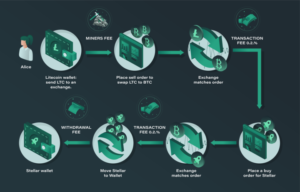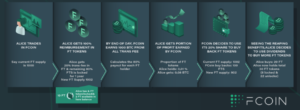World’s most controversial exchange, FCoin’s transaction mining undergoes a complete makeover
The introduction of its trans-mining approach back in May-June 2018 made FCoin very popular among traders. When the platform was launched, it quickly rose to fame and saw a massive surge in trading activity in a short period of time, reaching $17 Billion in 24-hour trading volume.
The token model worked for the intended purpose — to increase trading activity — but could not maintain it for very long. Many have alleged that either traders come to FCoin only to mine FTs and not for real trade, or it’s a work of bots. Soon the token price dropped. Unfortunately, token price was the central element to ensure the success of the exchange.
The same year (2018) FCoin founder and CEO Jian Zhang addressed the criticism by saying, “If you look back at history, all new things were not recognized at the beginning. Many were believed to be a fraud. Jack Ma was recognized as a fraud when he first promoted the internet in China.”
So, what happened, and how does FCoin plan to correct its token economy model?
What attracted the attention of traders when FCoin launched?
Today most of the digital exchanges need you to convert to a base currency — usually Bitcoin — before converting to another digital asset. This means you might end up paying a higher amount for your choice of the digital asset.
Suppose Alice has Litecoin and wants to sell them for Stellar token. This is how the swap in a traditional cryptocurrency exchange would look (Fig 1):

Add-up all fee structures and you see how expensive the process is. Currently, exchanges like Binance have a native token model wherein holders of Binance token receive a 50% discount on the transaction fee. However, this still does not compensate enough for the fee users pay for the swap in the exchange.
The most important thing that an exchange cares about is the daily trading volume. The bigger the trading volume, the more money it makes from transaction fees. The easiest way to attract traders to their trading platform is by providing an incentive to traders (i.e., discounting the transaction fee).
FCoin, launched in June 2018, touts a business model where all transaction fees get reimbursed to the users. For instance, for every transaction fee a user pays to FCoin, the platform reimburses the user 100 percent of the value in FT tokens.
Flaw in the Trans-fee mining model:
The incentive to get 100% reimbursements paid in the equivalent of FT tokens could only work if the token provides a stable value and growth. Without any intrinsic value or utility, FT token price soon collapsed from its peak $1.2 per FT to now $0.12 per FT.
Imagine a restaurant where you get reimbursed in coupons every time when you buy a burger. Say 35% worth the price you paid. Currently, the restaurant offers the best burgers in town and new customers are constantly coming in and buying burgers, Therefore, for now, the restaurant is able to run well.
Say the town where the restaurant is open, has a total population of 10,000 people.
What if eventually, all 10,000 people collect just enough coupons at the same time to have their next meal completely free.
The restaurant ends-up offering free meals, and sooner or later, the lack of working capital may cause the restaurant to close. Therefore, it needs a mechanism wherein coupon holders hold it for long-term and not immediately cash-out for a free meal.
While comparing the restaurant coupon model with FCoin Trans-mining (old model), In FCoin, the token supply is generated by the Trans-Fee Mining program. The continuous addition of tokens creates excess supply, causing inflation and therefore FT price continued its downward trend.
FCoin’s attempt to maintain equilibrium for FT Tokens
In terms of token economics, the price of the currency-like token depends on its supply and demand. When the demand is larger than supply, the token price goes up; and when the demand is smaller than supply, the price goes down.
Since in FCoin, traders can earn FT from their trades, there is no immediate rush to buy FT. More from the human psychology point of view, we value less the things which require no effort to gain. A perfect example in blockchain space is airdrops. Majority of airdrop holders don’t hold the token very long.
So, how FCoin tackles this problem. The key to resolve this problem is to create equilibrium in which market supply and demand balance each other. One way of doing it is to create a utility or establish the intrinsic value of the token, which motivates token holders to hold FTs longer rather than immediately cashing-out FCoin tokens.
Therefore, FCoin introduced the ‘daily-dividend’ structure where 80 percent of the revenue generated from collecting transaction fee (equivalent in FT or BTC or ETH) is distributed to the holders of FT token.
In theory, paying dividends should incentivize token holders to hold FT tokens. However, in practice, investors may drive down the token price by the amount of the dividend paid to account for the fact that market valuation or cap of the underlying asset does not change.
For example, $3 dividend per share payment made by Microsoft in the fall of 2004 caused shares to fall after ex-dividend date from $29.97 to $27.34.
Since BTC or FT pairs generated maximum trading volume, participants received dividends mostly in FT or BTC. As a result of this mechanism, the market now has more supply of FT tokens and traders rush to sell the tokens causing the FT token price to further drop.
Doing away with Trans-fee model and adoption of Sustainable Mining
Referring back to our restaurant case, what if the restaurant adds a condition wherein the coupon can only be availed after 3 months of the issuance and allow this promotion only for a limited time. By doing so, they avoid the circumstance where customers cash-out the coupon immediately and therefore, continue stable cash flow to the restaurant.
Similar to Restaurant adjusted coupon model, FCoin introduces the adjusted model called Sustainable Mining to make sure supply and demand in equilibrium and therefore, promote steady price growth of FT tokens.
As per the Sustainable Mining guidelines:
(1) For all new FTs earned from mining, 20% gets distributed to the traders and 80% gets locked for 1 year but holders continue to enjoy benefits or interests such as dividends and voting during the lockup period.
(2) To make sure FT supply and demand stability and inflation is in check, FCoin will control and adjust the mining output every 3 months. Depending on the circumstances at the time of the review, the refund amount will either remain unchanged or adjusted e.g. halved or stopped.
(3) A token that pays consistent dividends creates popularity among investors. Therefore, FCoin guarantees stable mining for at least three years.
(4) Repurchasing and destruction of the FT, in line with existing policies. (link to the policy). This ensures a healthy balance between supply and demand.
An illustration of how new model (daily-dividend and sustainable mining) balances out supply and demand of FCoin native token FT. (Note: for simplicity, we are using 1000 as current FT supply)

Token Economics plays a critical role for a token to function as the central element in the blockchain projects. If designed well, it grows the ecosystem. If not, a project will be unstable and soon loses value.
The switch to sustainable mining makes FCoin not only to stay competitive by providing an incentive to traders in the form of transaction fee reimbursement but also establishes a better economic incentive for stable demand for its native token FT.
After FCoin moved past the trans-fee model, the transition has been very successful and proves their focus to become an exchange which is owned and driven by the community. Till date, FCoin has never missed a daily dividend payout, regularly run community meetings and gathers users proposals to improve the experience in the platform.
Join FCoin exchange and enjoy 100% transaction fee reimbursement. To learn more about FCoin’s latest developments, join Telegram or Twitter.
